Waterproof-breathable PTFE nano- and Microfiber Membrane as High Efficiency PM2.5 Filter
Abstract
1. Introduction
2. Materials and Methods
2.1. Materials and apparatus
2.2. Nanofiber Membrane Preparation
2.2.1. Solution Preparation
2.2.2. Electrospinning Process
2.3. Membrane Characterization
2.3.1. Characterization of e-spun Membrane
2.3.2. Membrane Morphologies
2.3.3. Component Analysis
2.3.4. Membrane Pore Size Distribution
2.3.5. Water Contact Angle and Self-Cleaning
2.3.6. Membrane Breathability Test
2.3.7. Membrane Filter Efficiency
2.3.8. Reproducibility Test
3. Results
3.1. Micromorphology Analysis
3.2. Component Analysis
3.3. Membrane Pore Size Distribution
3.4. Hydrophobic Characterization
3.5. Membrane Breathability Test
3.6. Filtering Performance
3.7. Reproducibility Characterization
4. Discussion
5. Conclusions
Author Contributions
Funding
Conflicts of Interest
Abbreviations
| PTFE | polytetrafluoroethylene |
| PVA | poly (vinyl alcohol) |
| CPFMs | composite PTFE fiber membranes |
| PM | particulate matter |
References
- Zhang, R.; Liu, C.; Hsu, P.C.; Zhang, C.; Liu, N.; Zhang, J.; Lee, H.R.; Lu, Y.; Qiu, Y.; Chu, S.; et al. Nanofiber Air Filters with High-Temperature Stability for Efficient PM2.5 Removal from the Pollution Sources. Nano Lett. 2016, 16, 3642–3649. [Google Scholar] [CrossRef] [PubMed]
- Qu, W.J.; Arimoto, R.; Zhang, X.Y.; Zhao, C.H.; Wang, Y.Q.; Sheng, L.F.; Fu, G. Spatial distribution and interannual variation of surface PM10 concentrations over eighty-six Chinese cities. Atmos. Chem. Phys. 2010, 10, 5641–5662. [Google Scholar] [CrossRef]
- Liu, C.; Hsu, P.C.; Lee, H.W.; Ye, M.; Zheng, G.; Liu, N.; Li, W.; Cui, Y. Transparent air filter for high-efficiency PM2.5 capture. Nat. Commun. 2015, 6, 6205. [Google Scholar] [CrossRef] [PubMed]
- Pope, C.A., III; Dockery, D.W. Health effects of fine particulate air pollution: Lines that connect. Air Repair 2006, 56, 1368–1380. [Google Scholar] [CrossRef]
- Betha, R.; Behera, S.N.; Balasubramanian, R. 2013 Southeast Asian Smoke Haze: Fractionation of Particulate-Bound Elements and Associated Health Risk. Environ. Sci. Technol. 2014, 48, 4327–4335. [Google Scholar] [CrossRef] [PubMed]
- Brook, R.D.; Rajagopalan, S.; Pope, C.A., III; Brook, J.R.; Bhatnagar, A.; Diez-Roux, A.V.; Holguin, F.; Hong, Y.; Luepker, R.V.; Mittleman, M.A.; et al. Particulate Matter Air Pollution and Cardiovascular Disease an Update to the Scientific Statement from the American Heart Association. Circulation 2010, 121, 2331–2378. [Google Scholar] [CrossRef] [PubMed]
- Timonen, K.L.; Vanninen, E.; de Hartog, J.; Ibald-Mulli, A.; Brunekreef, B.; Gold, D.R.; Heinrich, J.; Hoek, G.; Lanki, T.; Peters, A.; et al. Effects of ultrafine and fine particulate and gaseous air pollution on cardiac autonomic control in subjects with coronary artery disease: The ULTRA study. J. Expo. Sci. Environ. Epidemiol. 2005, 16, 332–341. [Google Scholar] [CrossRef] [PubMed]
- Anenberg, S.C.; Horowitz, L.W.; Tong, D.Q.; West, J.J. An Estimate of the Global Burden of Anthropogenic Ozone and Fine Particulate Matter on Premature Human Mortality Using Atmospheric Modeling. Environ. Health Perspect. 2010, 118, 1189–1195. [Google Scholar] [CrossRef]
- Zhao, X.; Li, Y.; Hua, T.; Pan, J.; Xia, Y.; Yu, J.; Ding, B. Cleanable Air Filter Transferring Moisture and Effectively Capturing PM2.5. Small 2017, 13, 1603306. [Google Scholar] [CrossRef]
- Xu, J.; Liu, C.; Hsu, P.C.; Liu, K.; Zhang, R.; Liu, Y.; Cui, Y. Roll-to-Roll Transfer of Electrospun Nanofiber Film for High-Efficiency Transparent Air Filter. Nano Lett. 2016, 16, 1270. [Google Scholar] [CrossRef]
- Shi, S.; Chen, C. Assessment of Reduction in Indoor PM2.5 of Outdoor Origin by using Nanofiber Filters as Window Screens. Procedia Eng. 2017, 205, 2386–2392. [Google Scholar] [CrossRef]
- Jung, W.; Lee, J.S.; Han, S.; Ko, S.H.; Kim, T.; Kim, Y.H. An efficient reduced graphene-oxide filter for PM2.5 removal. J. Mater. Chem. A 2018, 6, 16975–16982. [Google Scholar] [CrossRef]
- Moradi, G.; Zinadini, S.; Rajabi, L.; Dadari, S. Fabrication of high flux and antifouling mixed matrix fumarate-alumoxane/PAN membranes via electrospinning for application in membrane bioreactors. Appl. Surf. Sci. 2018, 427, 830–842. [Google Scholar] [CrossRef]
- Yang, S.; Lei, P.; Shan, Y.; Zhang, D. Preparation and characterization of antibacterial electrospun chitosan/poly (vinyl alcohol)/graphene oxide composite nanofibrous membrane. Appl. Surf. Sci. 2018, 435, 832–840. [Google Scholar] [CrossRef]
- Yu, X.; Shen, L.; Zhu, Y.; Li, X.; Yang, Y.; Wang, X.; Zhu, M.; Hsiao, B.S. High performance thin-film nanofibrous composite hemodialysis membranes with efficient middle-molecule uremic toxin removal. J. Membr. Sci. 2017, 523, 173–184. [Google Scholar] [CrossRef]
- Wang, X.; Song, W.Z.; You, M.H.; Zhang, J.; Yu, M.; Fan, Z.; Ramakrishna, S.; Long, Y.Z. Bionic Single-Electrode Electronic Skin Unit Based on Piezoelectric Nanogenerator. ACS Nano 2018, 12, 8588–8596. [Google Scholar] [CrossRef] [PubMed]
- Yue, T.T.; Li, X.; Wang, X.X.; Yan, X.; Yu, M.; Ma, J.W.; Zhou, Y.; Ramakrishna, S.; Long, Y.Z. Electrospinning of Carboxymethyl Chitosan/Polyoxyethylene Oxide Nanofibers for Fruit Fresh-Keeping. Nanoscale Res. Lett. 2018, 13, 239. [Google Scholar] [CrossRef] [PubMed]
- Zhang, J.; Wang, X.X.; Zhang, B.; Ramakrishna, S.; Yu, M.; Ma, J.W.; Long, Y.Z. In situ assembly of well-dispersed Ag nanoparticles throughout electrospun alginate nanofibers for monitoring human breath—Smart fabrics. ACS Appl. Mater. Interfaces 2018, 10, 19863. [Google Scholar] [CrossRef]
- Liu, M.N.; Yan, X.; You, M.H.; Fu, J.; Nie, G.D.; Yu, M.; Ning, X.; Wan, Y.; Long, Y.Z. Reversible photochromic nanofibrous membranes with excellent water/windproof and breathable performance. J. Appl. Polym. Sci. 2018, 135, 46342. [Google Scholar] [CrossRef]
- You, M.H.; Wang, X.X.; Yan, X.; Zhang, J.; Song, W.Z.; Yu, M.; Fan, Z.; Ramakrishna, S.; Long, Y.Z. Self-Powered Flexible Hybrid Piezoelectric-Pyroelectric Nanogenerator based on Non-woven Nanofiber Membranes. J. Mater. Chem. A 2018, 6, 3500–3509. [Google Scholar] [CrossRef]
- Zhang, B.; Zhang, Z.G.; Yan, X.; Wang, X.X.; Zhao, H.; Guo, J.; Feng, J.Y.; Long, Y.Z. Chitosan nanostructures by in situ electrospinning for high-efficiency PM2.5 capture. Nanoscale 2017, 9, 4154–4161. [Google Scholar] [CrossRef] [PubMed]
- Wang, L.; Yang, J.; Ran, B.; Yang, X.; Zheng, W.; Long, Y.Z.; Jiang, X. Small Molecular TGF-β1 Inhibitor Loaded Electrospun Fibrous Scaffolds for Preventing Hypertrophic Scars. Acs Appl. Mater. Interfaces 2017, 9, 32545–32553. [Google Scholar] [CrossRef] [PubMed]
- Zhang, B.; Yan, X.; He, H.W.; Yu, M.; Ning, X.; Long, Y.Z. Solvent-free electrospinning: Opportunities and challenges. Polym. Chem. 2016, 8, 333–352. [Google Scholar] [CrossRef]
- Liu, G.S.; Yan, X.; Yan, F.F.; Chen, F.X.; Hao, L.Y.; Chen, S.J.; Lou, T.; Ning, X.; Long, Y.Z. In Situ Electrospinning Iodine-Based Fibrous Meshes for Antibacterial Wound Dressing. Nanoscale Res. Lett. 2018, 13, 309. [Google Scholar] [CrossRef]
- Wang, F.; Zhu, H.; Zhang, H.; Tang, H.; Chen, J.; Guo, Y. An elastic microporous material with tunable optical property. Mater. Lett. 2016, 164, 376–379. [Google Scholar] [CrossRef]
- Huang, Q.L.; Xiao, C.F.; Hu, X.Y.; Li, X.F. Study on the effects and properties of hydrophobic poly(tetrafluoroethylene) membrane. Desalination 2011, 277, 187–192. [Google Scholar] [CrossRef]
- Iacovetta, D.; Tam, J.; Erb, U. Synthesis, structure, and properties of superhydrophobic nickel–PTFE nanocomposite coatings made by electrodeposition. Surf. Coat. Technol. 2015, 279, 134–141. [Google Scholar] [CrossRef]
- Takagi, Y.; Lee, J.C.; Yagi, S.I.; Yamane, H.; Wano, T.; Kitagawa, D.; Salmawy, A.E. Fiber making directly from poly(tetrafluoroethylene) emulsion. Polymer 2011, 52, 4099–4105. [Google Scholar] [CrossRef]
- Kang, X.; Sun, J.; Mo, Y.; Zhou, F.; Peng, L.; Xia, H.; Ma, J.; Ma, B. Effect of membrane pore morphology on microfiltration organic fouling: PTFE/PVDF blend membranes compared with PVDF membranes. Desalination 2014, 343, 217–225. [Google Scholar]
- Zhu, S.J.; Zhou, Y.Y.; Takashi, O.; Wu, G. Preparation of Polytetrafluoroethylene Ultrafine Fiber Mats with Electrospinning Process. Mater. Sci. Forum 2011, 675–677, 827–830. [Google Scholar] [CrossRef]
- Borkar, S.; Gu, B.; Dirmyer, M.; Delicado, R.; Sen, A.; Jackson, B.R.; Badding, J.V. Polytetrafluoroethylene nano/microfibers by jet blowing. Polymer 2006, 47, 8337–8343. [Google Scholar] [CrossRef]
- Goessi, M.; Tervoort, T.; Smith, P. Melt-spun poly(tetrafluoroethylene) fibers. J. Mater. Sci. 2007, 42, 7983–7990. [Google Scholar] [CrossRef]
- Ochoa, I.; Hatzikiriakos, S.G. Paste extrusion of polytetrafluoroethylene (PTFE): Surface tension and viscosity effects. Powder Technol. 2005, 153, 108–118. [Google Scholar] [CrossRef]
- Patil, P.D.; Ochoa, I.; Feng, J.J.; Hatzikiriakos, S.G. Viscoelastic flow simulation of polytetrafluoroethylene (PTFE) paste extrusion. J. Non-Newton. Fluid Mech. 2008, 153, 25–33. [Google Scholar] [CrossRef]
- Zhu, M.; Han, J.; Wang, F.; Shao, W.; Xiong, R.; Zhang, Q.; Pan, H.; Yang, Y.; Samal, S.K.; Zhang, F. Electrospun Nanofibers Membranes for Effective Air Filtration. Macromol. Mater. Eng. 2016, 302, 1600353. [Google Scholar] [CrossRef]
- Liang, Y.; Ju, J.; Deng, N.; Zhou, X.; Yan, J.; Kang, W.; Cheng, B. Super-hydrophobic self-cleaning bead-like SiO2@PTFE nanofiber membranes for waterproof-breathable applications. Appl. Surf. Sci. 2018, 442, 54–64. [Google Scholar] [CrossRef]
- Lin, J.H.; Huang, C.L.; Li, T.T.; Lee, Y.M.; Wu, Z.H.; Lou, C.W. Extended PTFE fabrics used as high-temperature filter clothes: Manufacturing technique and chemical stability evaluation. J. Text. Inst. Proc. Abstr. 2015, 106, 793–799. [Google Scholar] [CrossRef]
- Ignacz, G.; Fei, F.; Szekely, G. Ion-Stabilized Membranes for Demanding Environments Fabricated from Polybenzimidazole and Its Blends with Polymers of Intrinsic Microporosity. ACS Appl. Nano Mater. 2018, 1, 6349–6356. [Google Scholar] [CrossRef]
- Meringolo, C.; Poerio, T.; Fontananova, E.; Mastropietro, T.F.; Nicoletta, F.P.; De Filpo, G.; Curcio, E.; Profio, G.D. Exploiting Fluoropolymers Immiscibility to Tune Surface Properties and Mass Transfer in Blend Membranes for Membrane Contactor Applications. ACS Appl. Polym. Mater. 2019, 1, 326–334. [Google Scholar] [CrossRef]
- Zhao, D.; Kim, J.F.; Ignacz, G.; Pogany, P.; Lee, Y.M.; Szekely, G. Bio-Inspired Robust Membranes Nanoengineered from Interpenetrating Polymer Networks of Polybenzimidazole/Polydopamine. ACS Nano 2019, 13, 125–133. [Google Scholar] [CrossRef]
- Abdul Mannan, H.; Yih, T.M.; Nasir, R.; Muhktar, H.; Mohshim, D.F. Fabrication and characterization of polyetherimide/polyvinyl acetate polymer blend membranes for CO2/CH4 separation. Polym. Eng. Sci. 2019, 59, E293–E301. [Google Scholar] [CrossRef]
- Jang, S.; Yoon, Y.-G.; Lee, Y.-S.; Choi, Y.-W. One-step fabrication and characterization of reinforced microcomposite membranes for polymer electrolyte membrane fuel cells. J. Membr. Sci. 2018, 563, 896–902. [Google Scholar] [CrossRef]
- Wang, R.; Yang, C.; Fang, K.; Cai, Y.; Hao, L. Removing the residual cellulase by graphene oxide to recycle the bio-polishing effluent for dyeing cotton fabrics. J. Environ. Manag. 2018, 207, 423–431. [Google Scholar] [CrossRef] [PubMed]
- Hao, L.; Wang, R.; Zhao, Y.; Fang, K.; Cai, Y. The enzymatic actions of cellulase on periodate oxidized cotton fabrics. Cellulose 2018, 25, 6759–6769. [Google Scholar] [CrossRef]
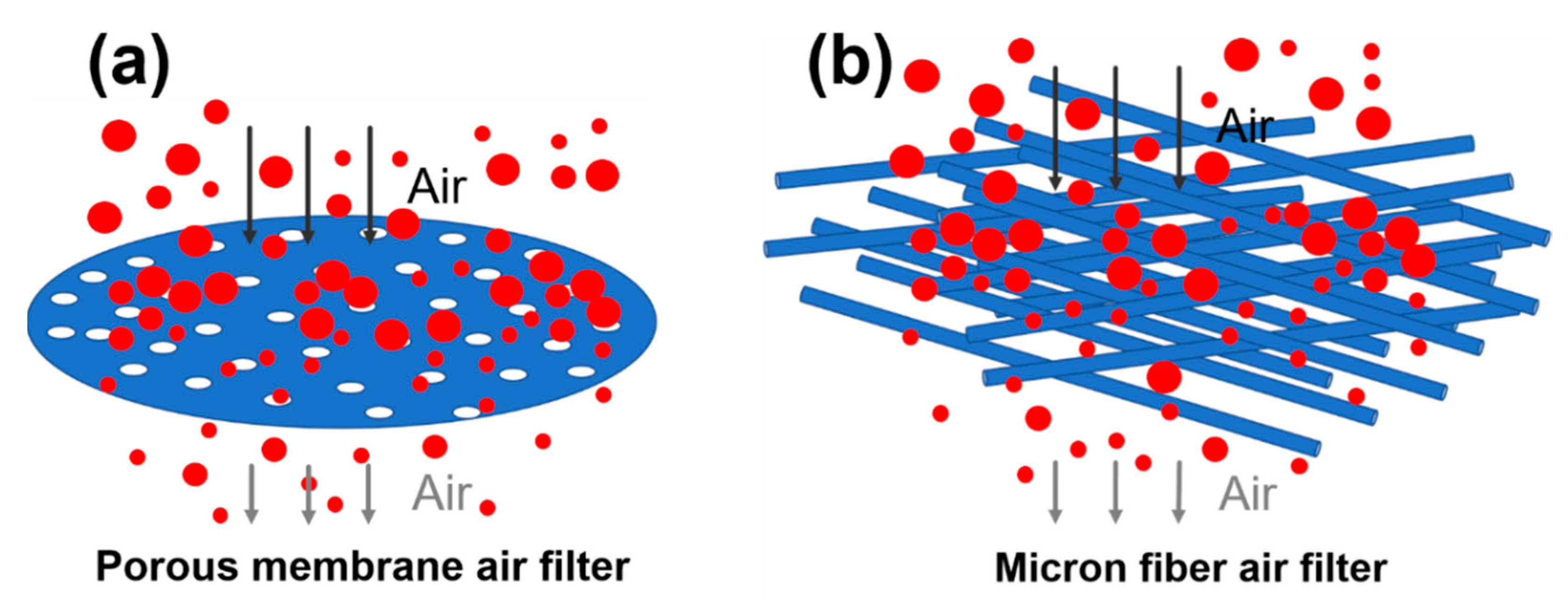
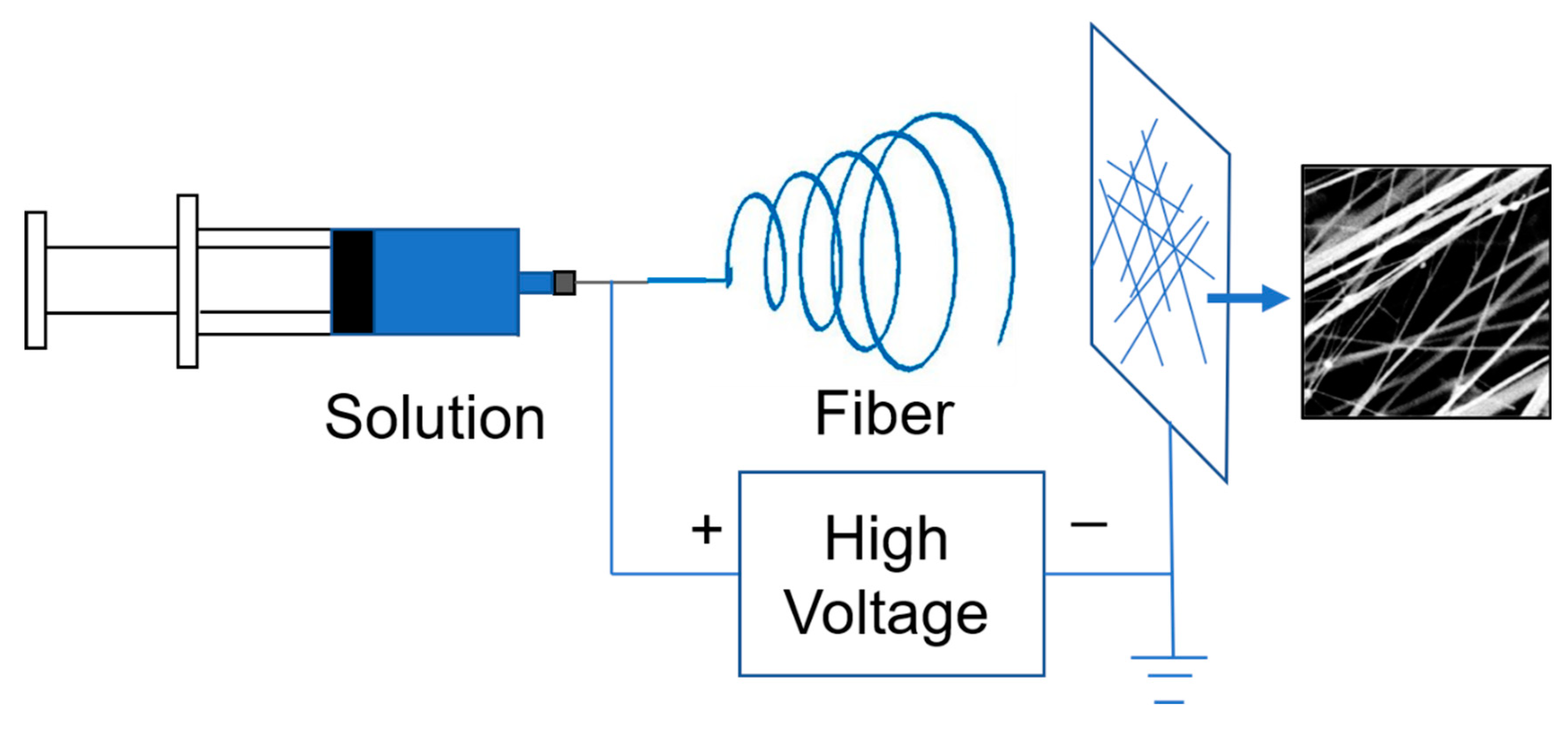
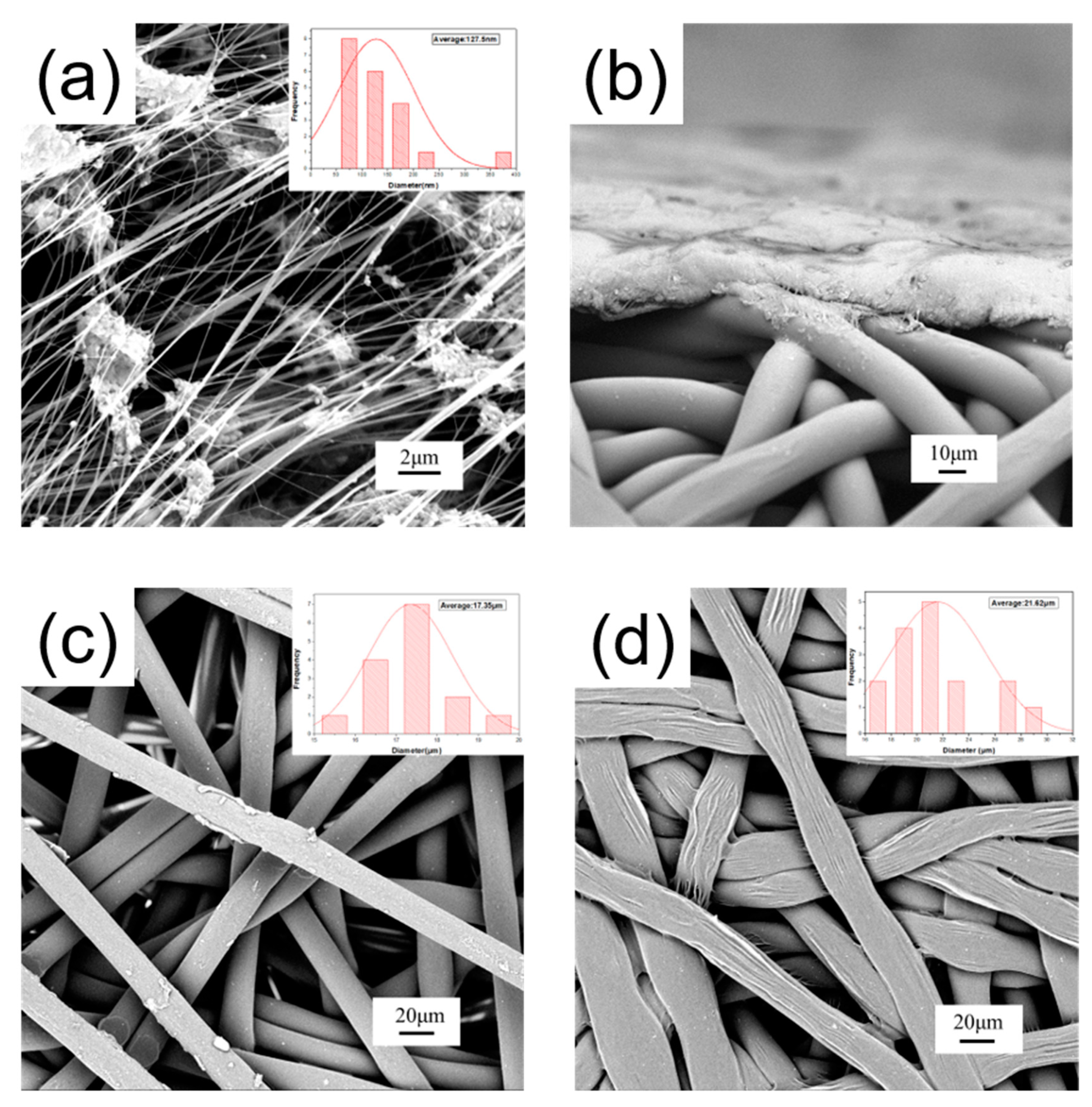
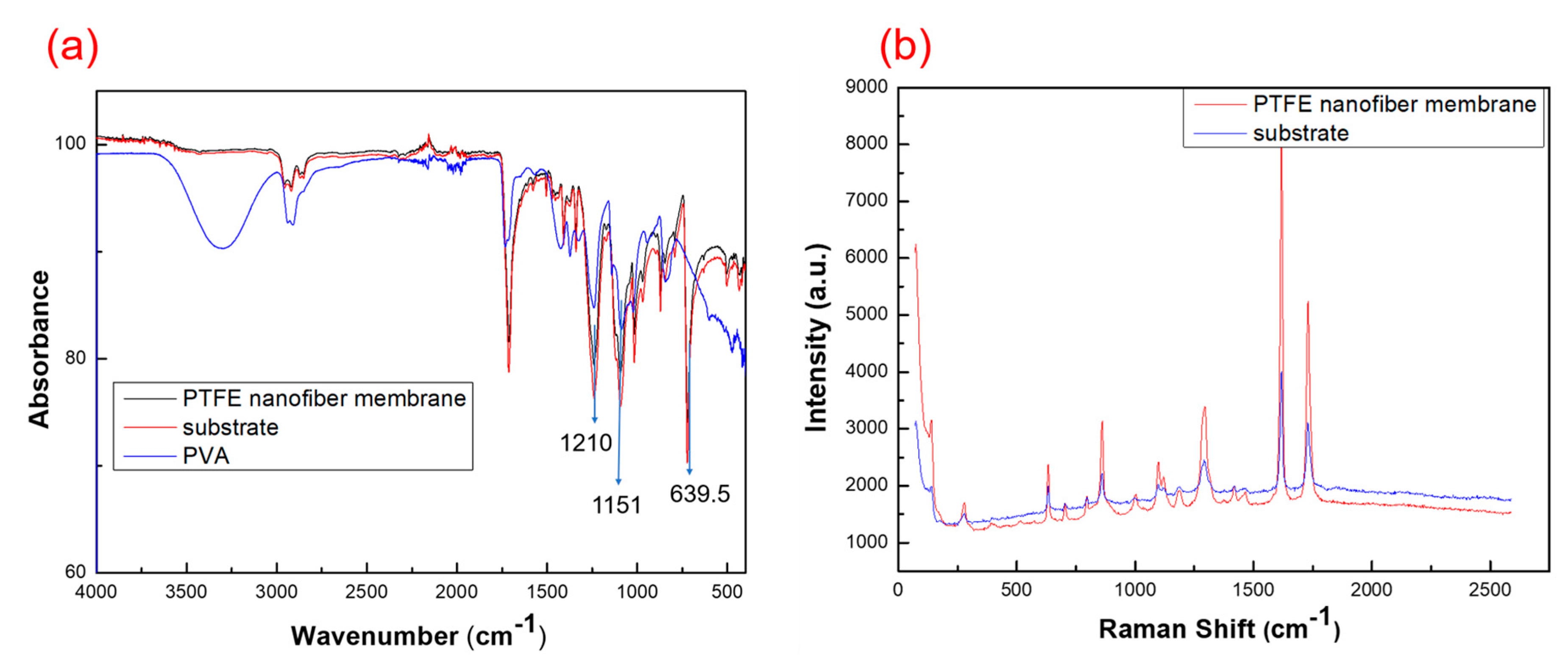
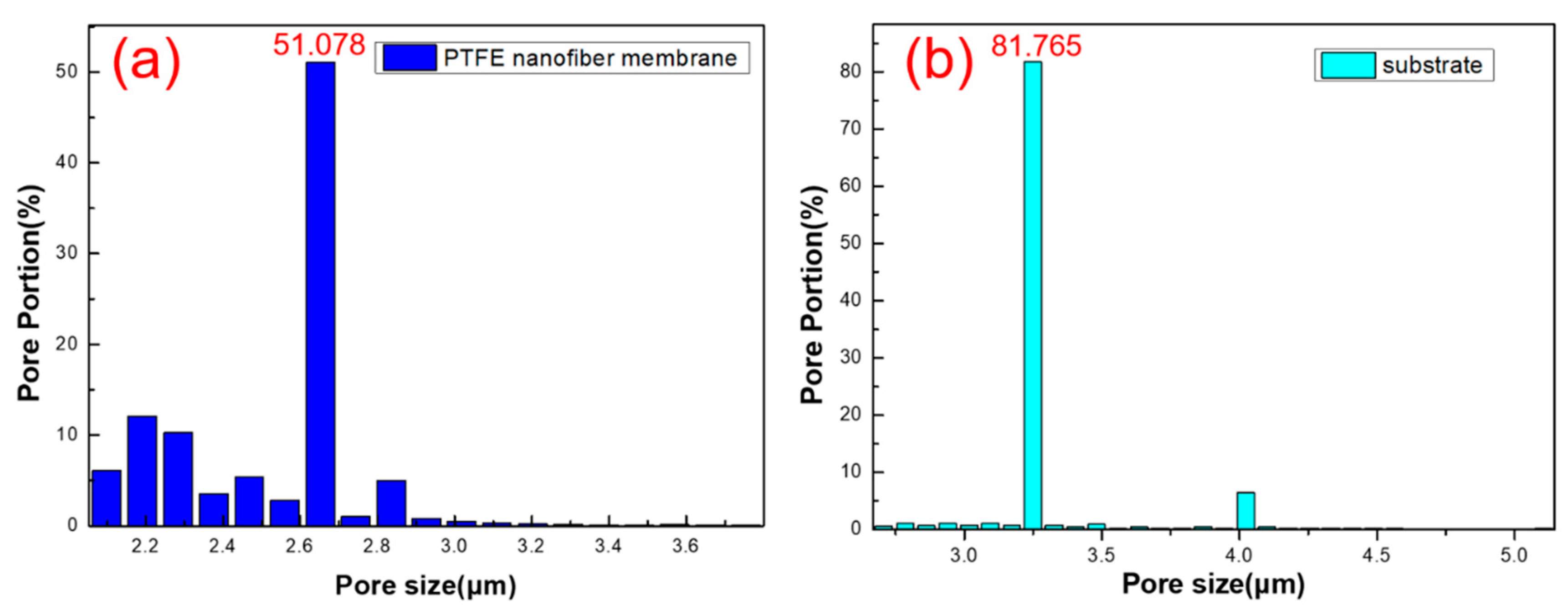
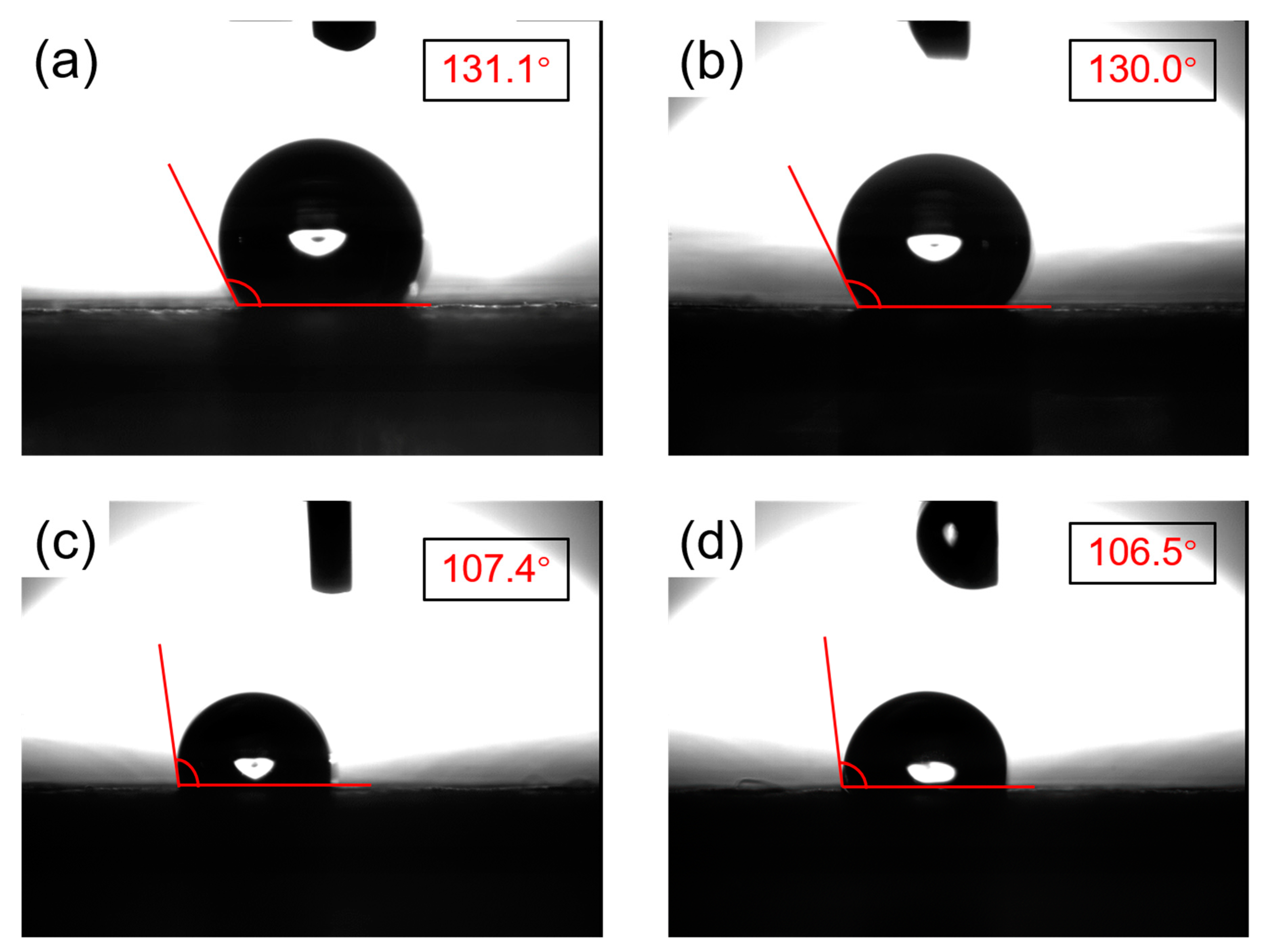
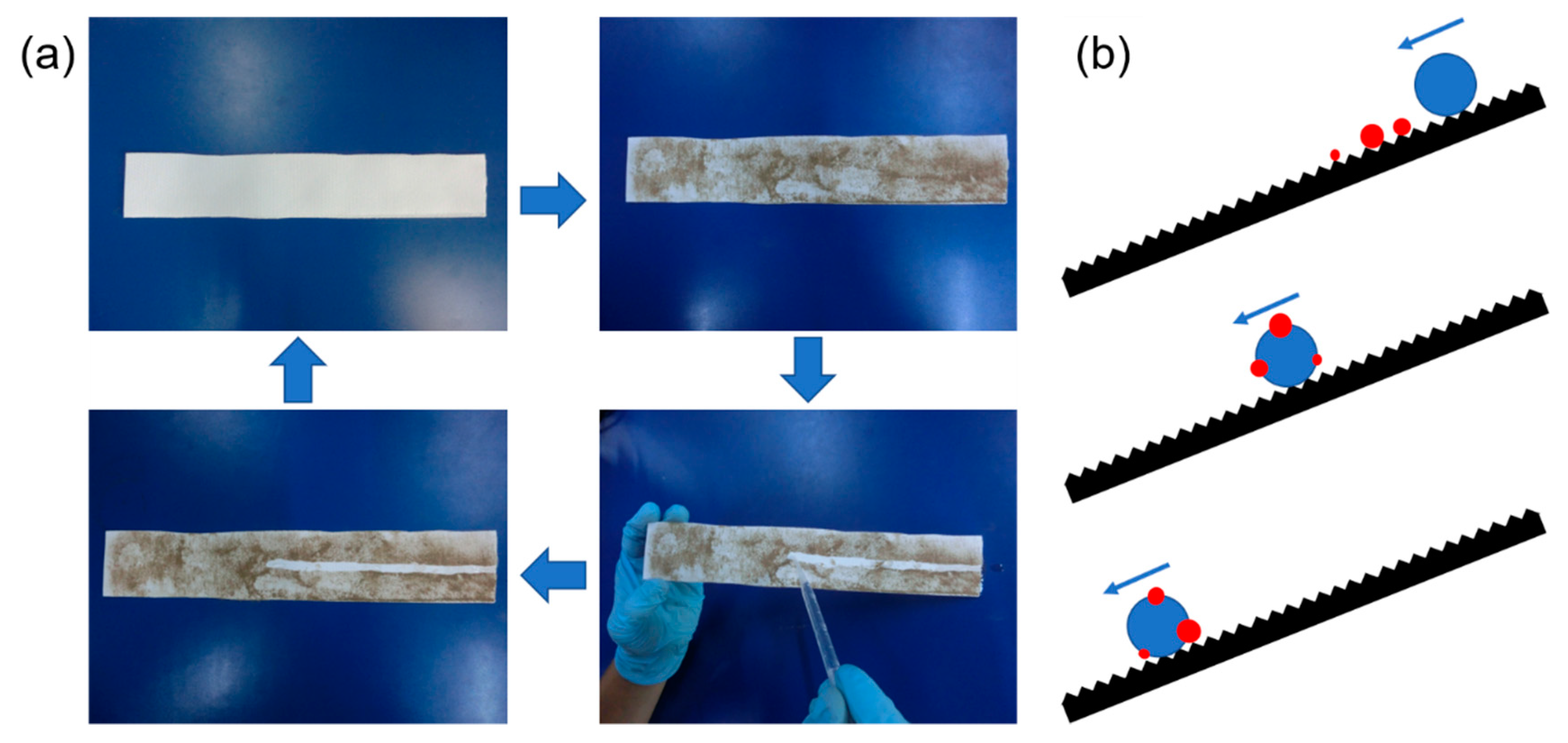
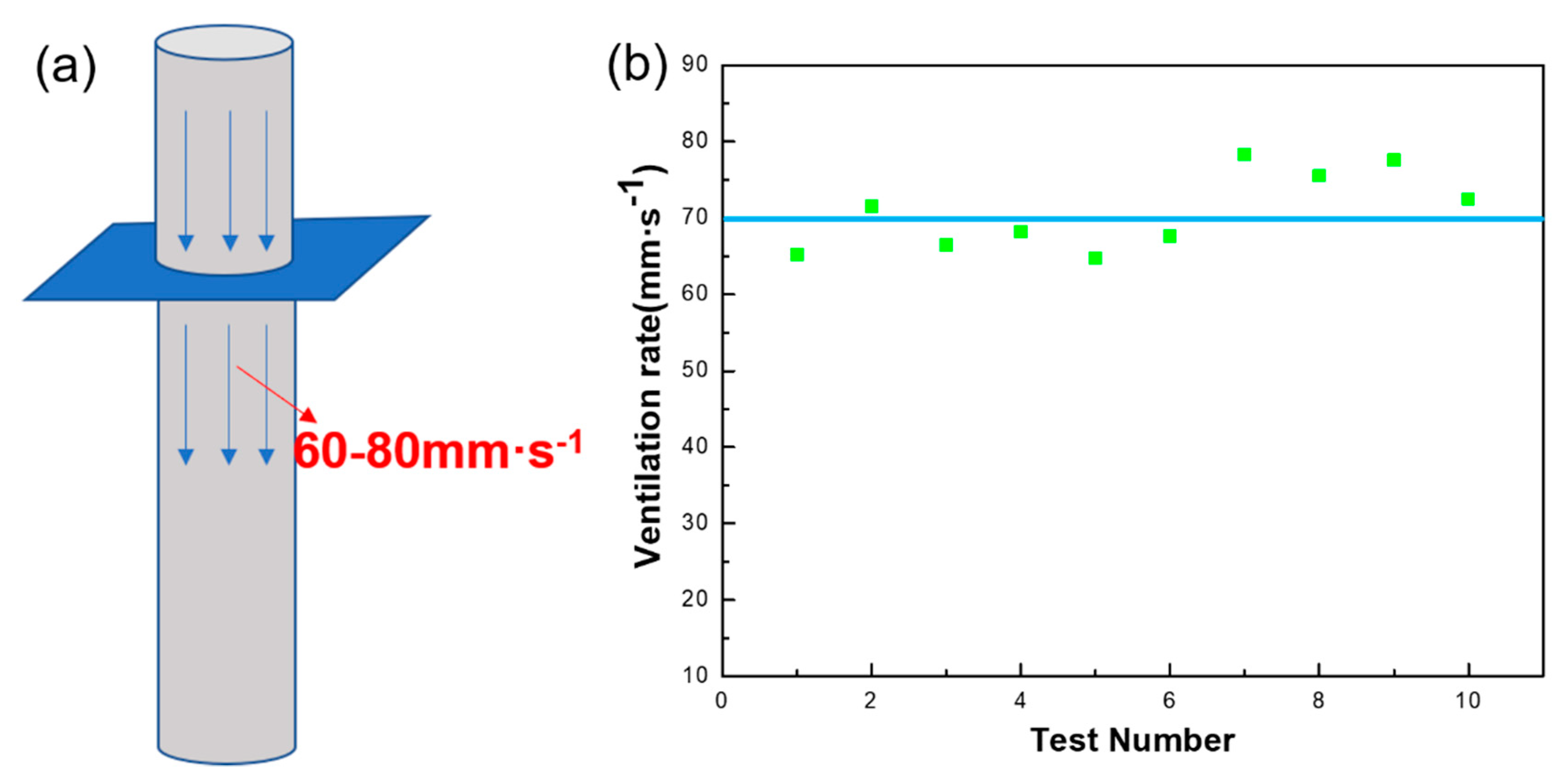
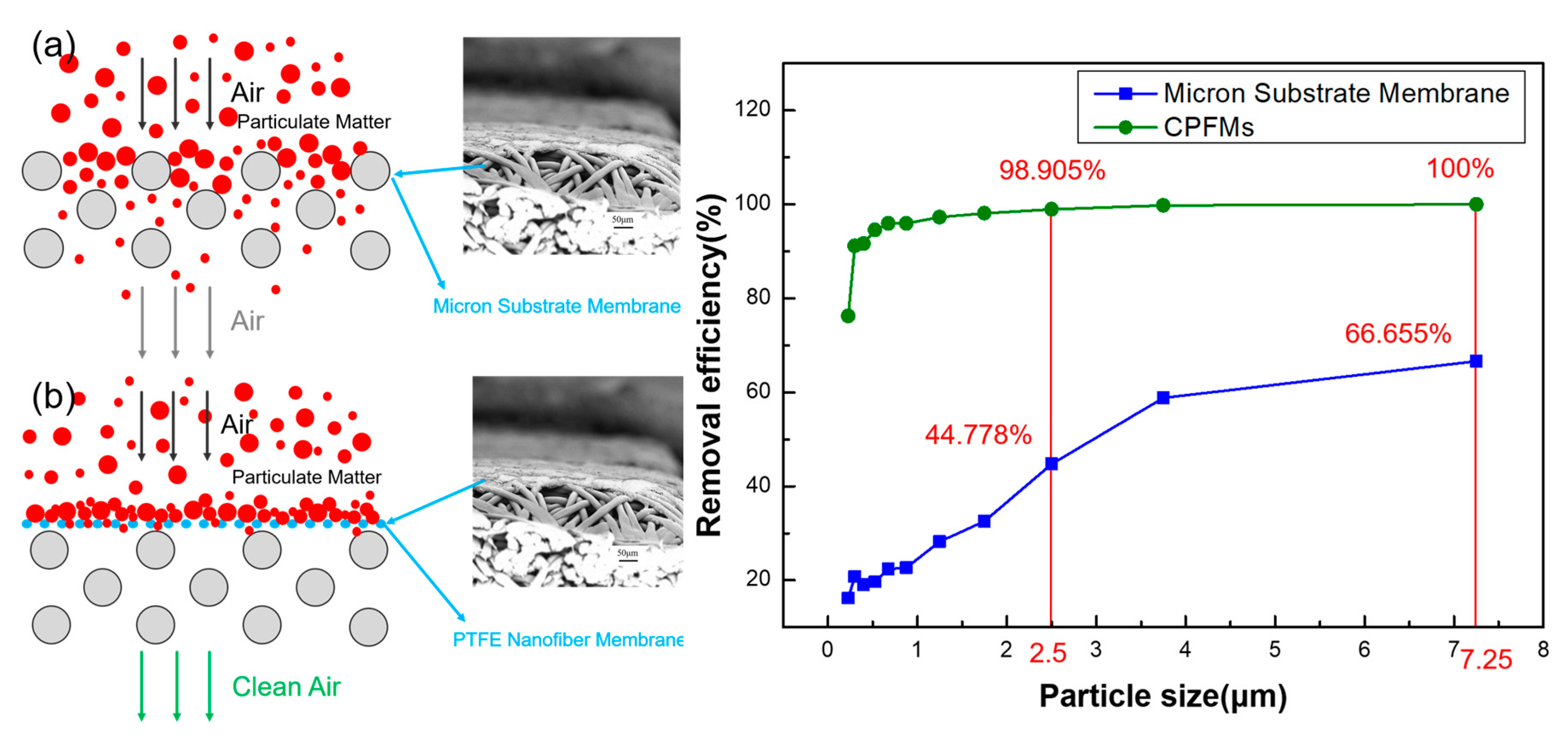
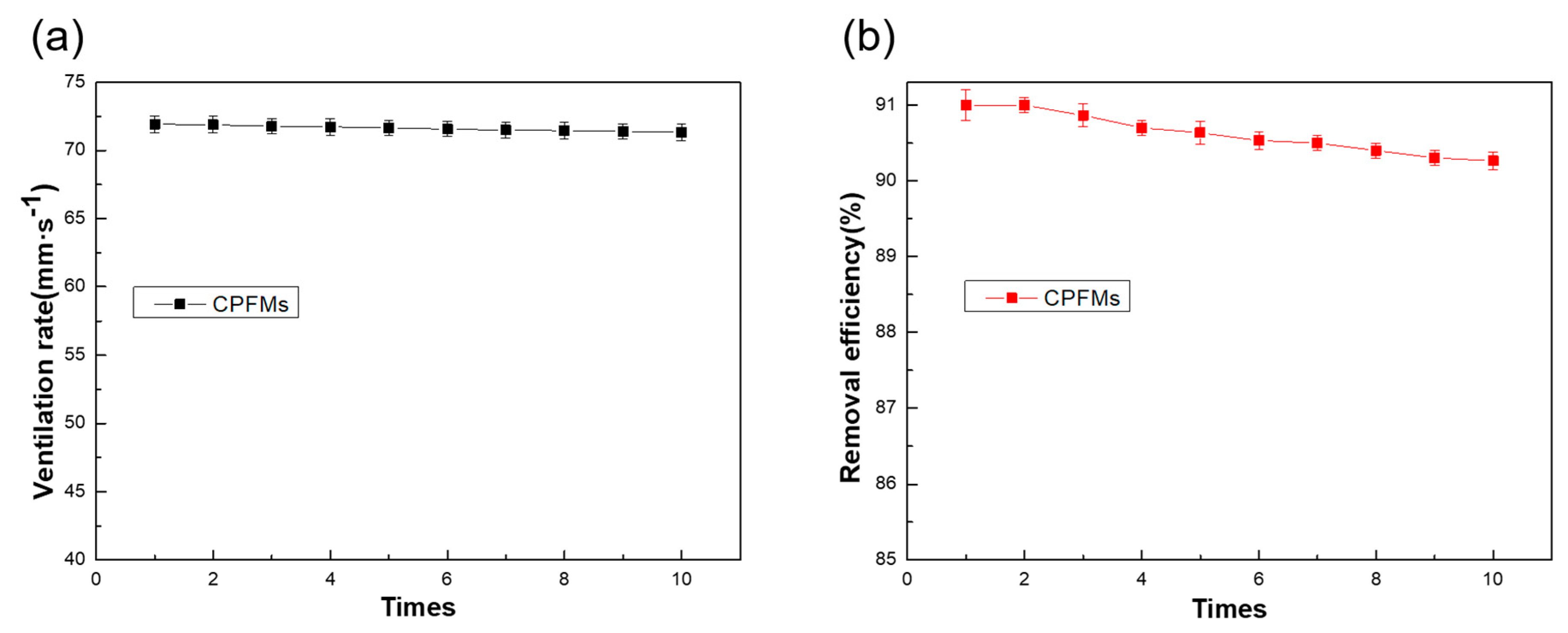
© 2019 by the authors. Licensee MDPI, Basel, Switzerland. This article is an open access article distributed under the terms and conditions of the Creative Commons Attribution (CC BY) license (http://creativecommons.org/licenses/by/4.0/).
Share and Cite
Li, X.; Wang, X.-X.; Yue, T.-T.; Xu, Y.; Zhao, M.-L.; Yu, M.; Ramakrishna, S.; Long, Y.-Z. Waterproof-breathable PTFE nano- and Microfiber Membrane as High Efficiency PM2.5 Filter. Polymers 2019, 11, 590. https://doi.org/10.3390/polym11040590
Li X, Wang X-X, Yue T-T, Xu Y, Zhao M-L, Yu M, Ramakrishna S, Long Y-Z. Waterproof-breathable PTFE nano- and Microfiber Membrane as High Efficiency PM2.5 Filter. Polymers. 2019; 11(4):590. https://doi.org/10.3390/polym11040590
Chicago/Turabian StyleLi, Xiao, Xiao-Xiong Wang, Tian-Tian Yue, Yuan Xu, Ming-Liang Zhao, Miao Yu, Seeram Ramakrishna, and Yun-Ze Long. 2019. "Waterproof-breathable PTFE nano- and Microfiber Membrane as High Efficiency PM2.5 Filter" Polymers 11, no. 4: 590. https://doi.org/10.3390/polym11040590
APA StyleLi, X., Wang, X.-X., Yue, T.-T., Xu, Y., Zhao, M.-L., Yu, M., Ramakrishna, S., & Long, Y.-Z. (2019). Waterproof-breathable PTFE nano- and Microfiber Membrane as High Efficiency PM2.5 Filter. Polymers, 11(4), 590. https://doi.org/10.3390/polym11040590







